
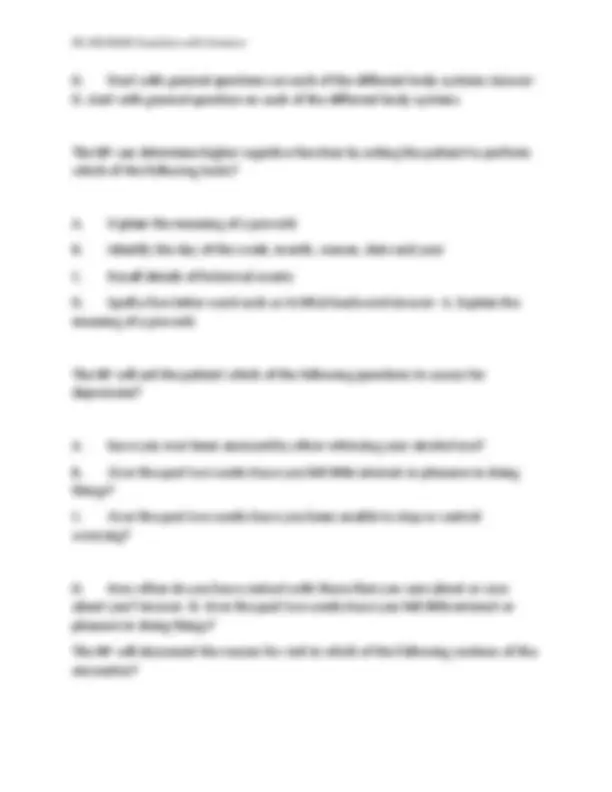
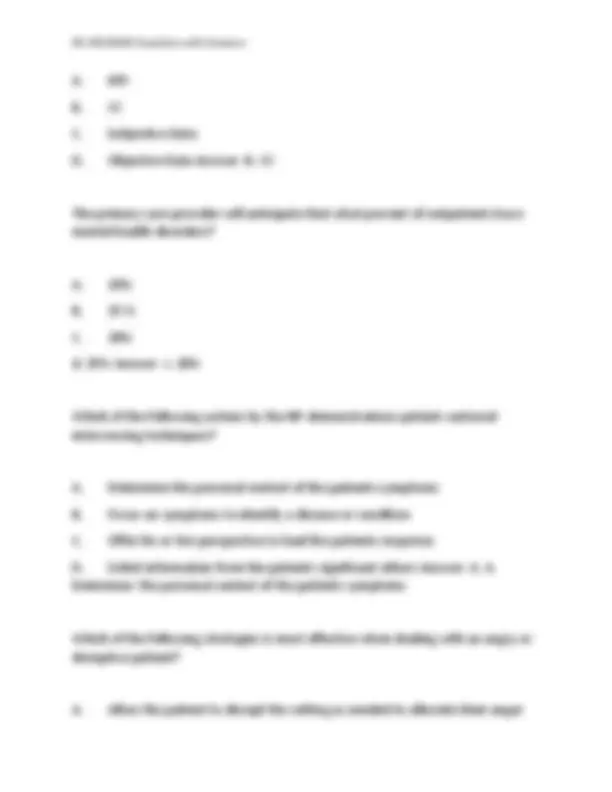
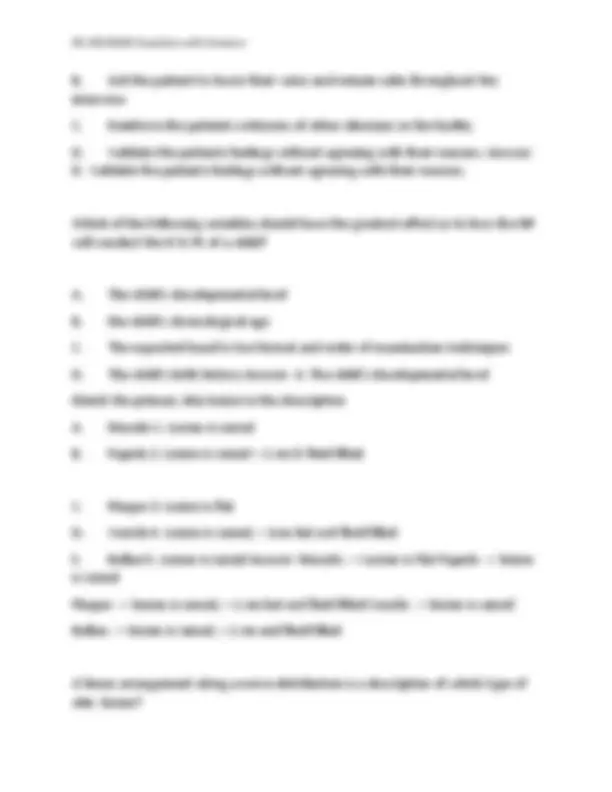
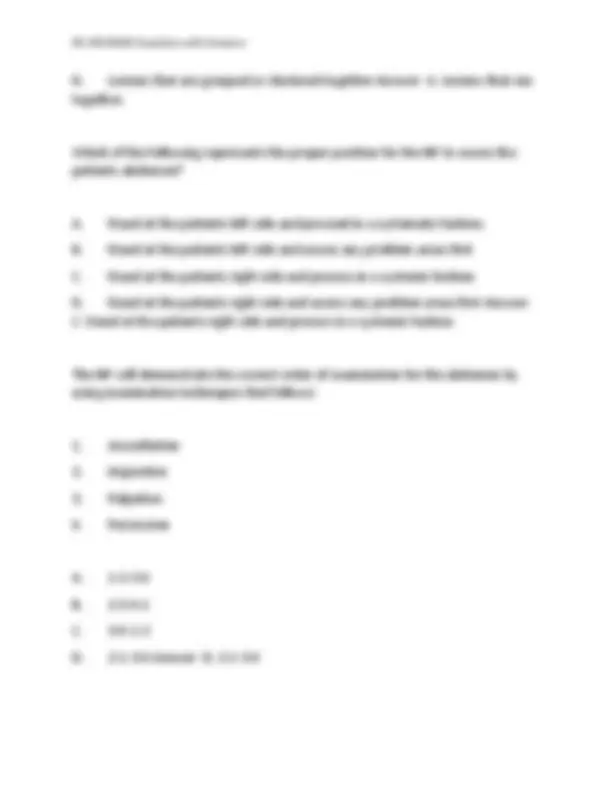
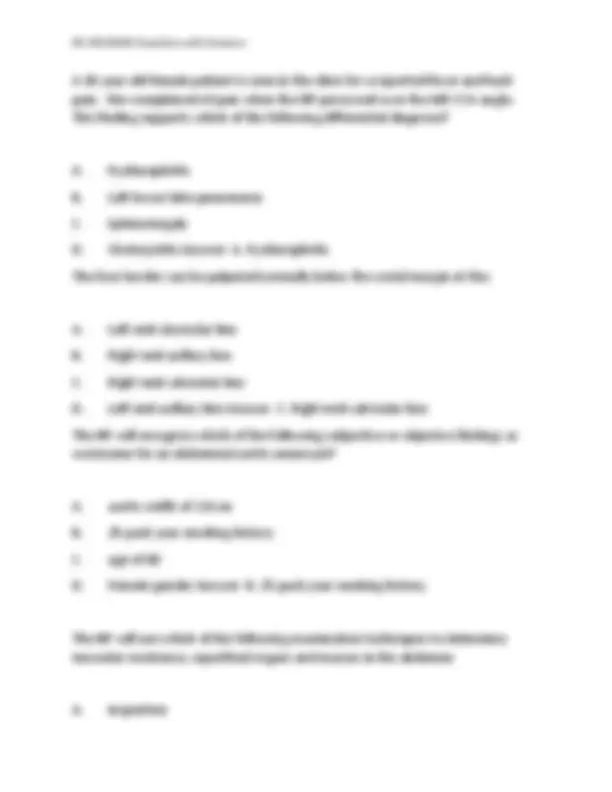
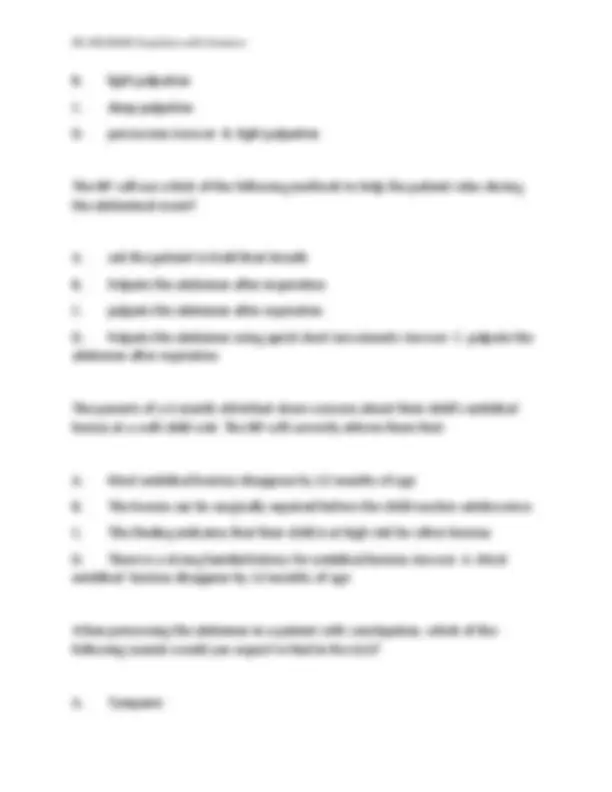
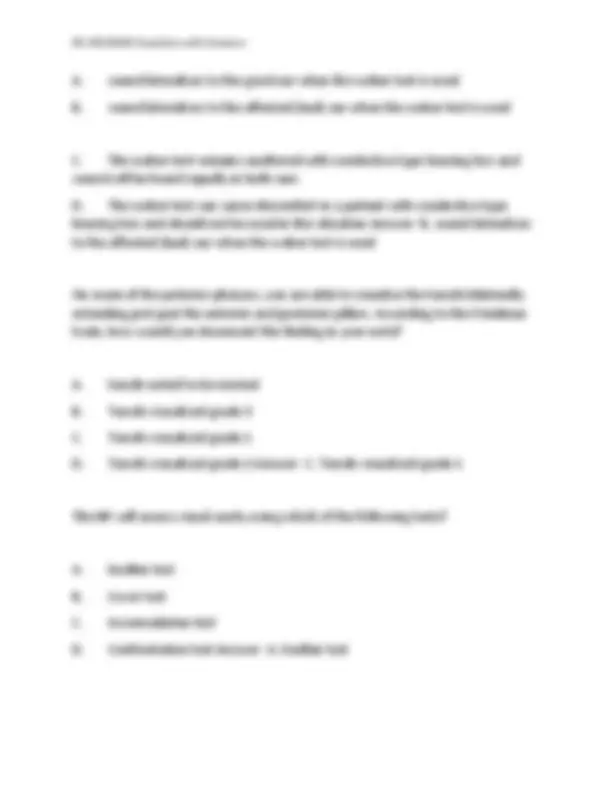
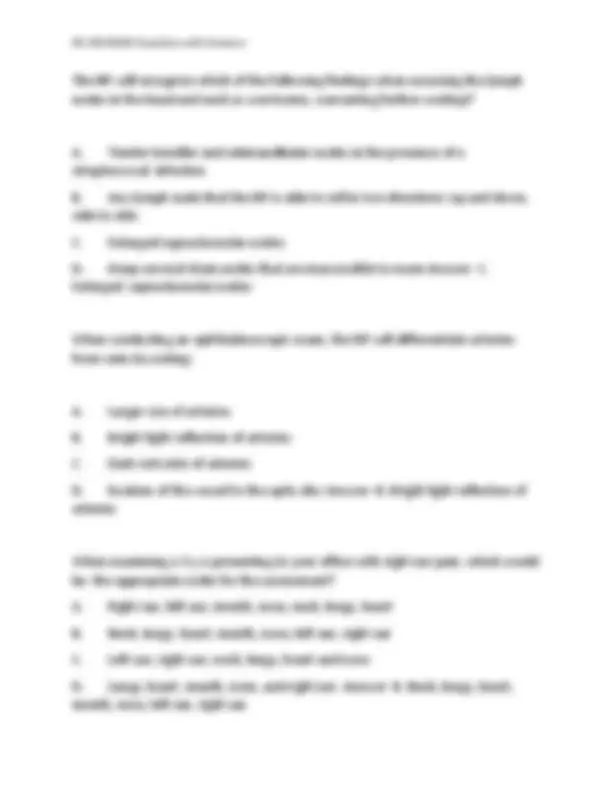
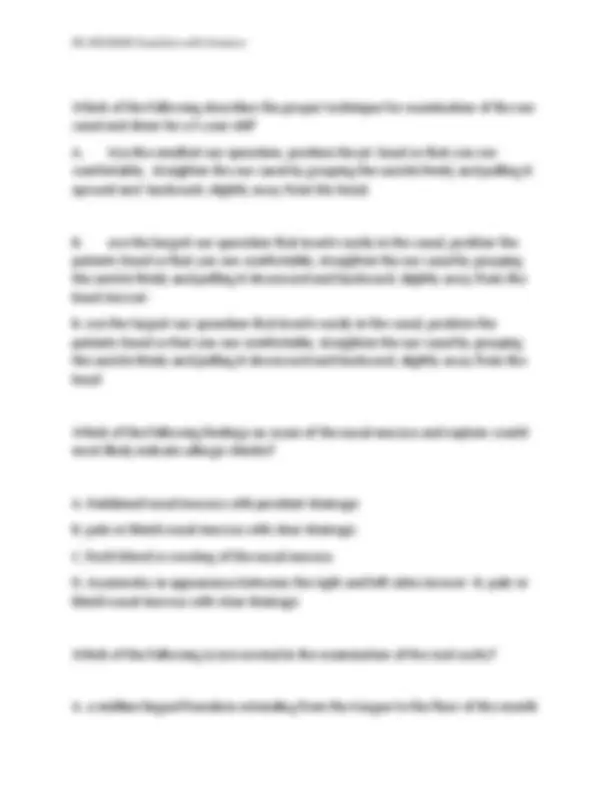
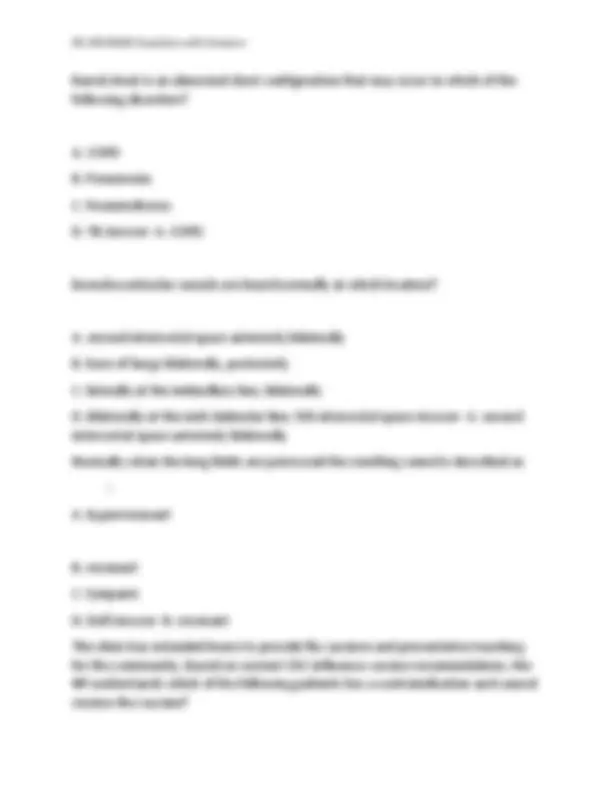
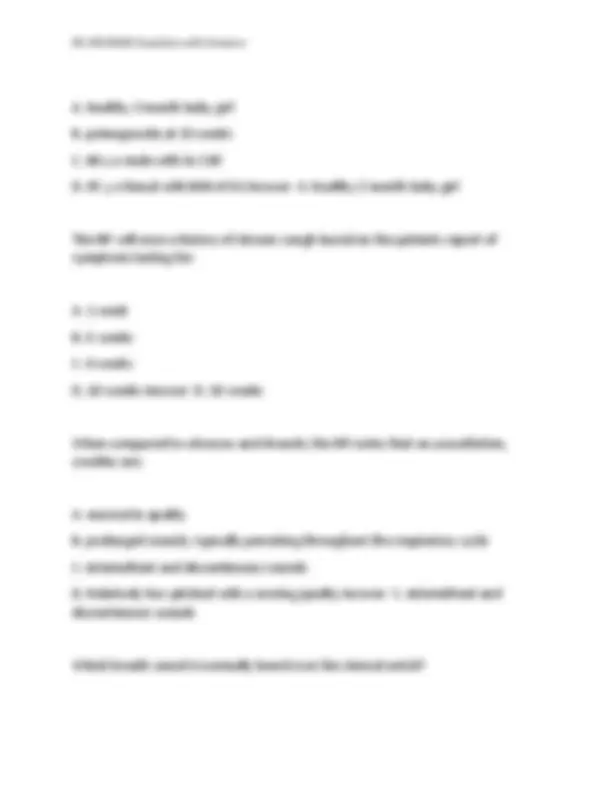
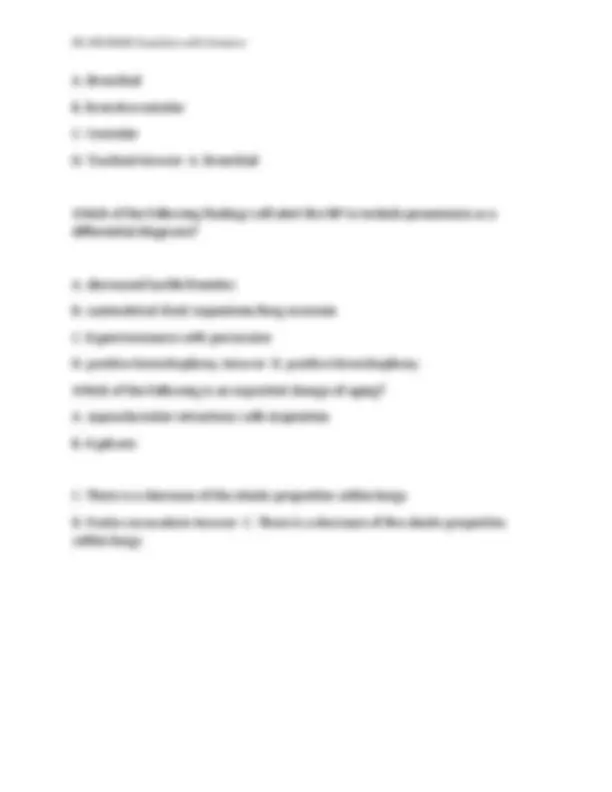


Study with the several resources on Docsity

Earn points by helping other students or get them with a premium plan


Prepare for your exams
Study with the several resources on Docsity

Earn points to download
Earn points by helping other students or get them with a premium plan
Community
Ask the community for help and clear up your study doubts
Discover the best universities in your country according to Docsity users
Free resources
Download our free guides on studying techniques, anxiety management strategies, and thesis advice from Docsity tutors
A patient is seen in the office for amenorrhea for which you obtain a urine pregnancy test in the office that returned negative. You would document this finding which of the following sections of the encounter role? correct answer: Objective data A patient you are seeing for the first time in your office, brings their previous medical records for your review. You would document a summary of the previous medical records in which of the following sections of the encounter note? correct answer: Subjective data The most effective process to elicit the review of systems is for the NP to: correct answer: Start with general questions on each of the different body systems The NP can determine higher cognitive function by asking the patient to perform which of the following tasks? correct answer: Explain the meaning of a proverb The NP will ask the patient which of the following questions to assess for depression? correct answer: Over the past two weeks have you felt little interest or pleasure
Typology: Exams
1 / 20

This page cannot be seen from the preview
Don't miss anything!













A patient is seen in the office for amenorrhea, for which you obtain a urine pregnancy test in the office that returns negative. You would document this finding in which of the following sections of the encounter?
A. HPI B. CC C. Subjective Data D. Objective Data Answer- D. Objective Data
A patient you are seeing for the first time in your office, brings their previous medical records for the review. you would document a summer of the previous medical records in which of the following sections of the encounter note?
C. Subjective Data D. Objective Data Answer- C. Subjective Data
The most effective process to elicit the ROS is for the NP to:
A. Limit the ROS to systems related to the CC B. Follow the patients lead regarding the order of symptoms C. incorporate the ROS during the physical exam, stopping to make notes as necessary
C. Subjective Data D. Objective Data Answer- B. CC
The primary care provider will anticipate that what percent of outpatients have mental health disorders?
d. 25% Answer- c. 20%
Which of the following actions by the NP demonstrations patient-centered interviewing techniques?
A. Determine the personal context of the patients symptoms B. Focus on symptoms to identify a disease or condition C. Offer his or her perspective to lead the patients response D. Solicit information from the patients significant others Answer- A. A. Determine the personal context of the patients symptoms
Which of the following strategies is most effective when dealing with an angry or disruptive patient?
A. Allow the patient to disrupt the setting as needed to alleviate their anger
B. Ask the patient to lower their voice and remain calm throughout the interview C. Reinforce the patients criticisms of other clinicians or the facility D. Validate the patients feelings without agreeing with their reasons. Answer- D. Validate the patients feelings without agreeing with their reasons.
Which of the following variables should have the greatest affect as to how the NP will conduct the H & PE of a child?
A. The child's developmental level B. the child's chronological age C. The expected head to toe format and order of examination techniques D. The child's birth history Answer- A. The child's developmental level Match the primary skin lesion to the description A. Macule 1. Lesion is raised B. Papule 2. Lesion is raised > 1 cm & fluid filled
C. Plaque 3. Lesion is flat D. Vesicle 4. Lesion is raised, > 1cm but not fluid filled E. Bullae 5. Lesion is raised Answer- Macule --> Lesion is Flat Papule --> lesion is raised Plaque --> lesion is raised, > 1 cm but not fluid filled Vesicle --> lesion is raised Bullae --> lesion is raised, > 1 cm and fluid filled
A linear arrangement along a nerve distribution is a description of which type of skin lesion?
A. bulla B. wheal C. nodule D. papule Answer- D. Papule
Which of the following objective findings would alert the NP to consider skin cancer in the list of differential diagnoses? A. Annular and symmetrical lesions B. Blurred edges to a raised lesion C. solid red raised lesion D. Diameter of 5 mm Answer- B. Blurred edges to a raised lesion
Which of the following secondary lesions is usually the result of a self-inflicted abrasion? A. Excoriation B. Scale C. Lichenification D. Atrophy Answer- A. Excoriation
You have just read in the patients chart that she has a lesion that is confluent in nature. On exam you would expect to find:
A. lesions that run together B. Angular lesions that have grown together C. Lesions arranged in a line along a nerve route
D. Lesions that are grouped or clustered together Answer- A. Lesions that run together.
Which of the following represents the proper position for the NP to assess the patients abdomen?
A. Stand at the patients left side and proceed in a systematic fashion. B. Stand at the patients left side and assess any problem areas first C. Stand at the patients right side and process in a systemic fashion D. Stand at the patients right side and assess any problem areas first Answer- C. Stand at the patients right side and process in a systemic fashion
The NP will demonstrate the correct order of examination for the abdomen by using examination techniques that follows:
D. 2-1-3-4 Answer- D. 2-1-3-
B. light palpation C. deep palpation D. percussion Answer- B. light palpation
The NP will use which of the following methods to help the patient relax during the abdominal exam?
A. ask the patient to hold their breath B. Palpate the abdomen after inspiration C. palpate the abdomen after expiration D. Palpate the abdomen using quick short movements Answer- C. palpate the abdomen after expiration
The parents of a 4 month old infant share concern about their child's umbilical hernia at a well-child visit. The NP will correctly inform them that:
A. Most umbilical hernias disappear by 12 months of age B. The hernia can be surgically repaired before the child reaches adolescence C. This finding indicates that their child is at high risk for other hernias D. There is a strong familial history for umbilical hernias Answer- A. Most umbilical hernias disappear by 12 months of age
When percussing the abdomen in a patient with constipation, which of the following sounds would you expect to find in the LLQ?
A. Tympanic
B. Dull C. Resonant D. Hyperresonant Answer- B. Dull When percussing the abdomen, you would document the normal finding of percussion over the intestines as:
A. Tympanic B. Dull C. Resonant D. Hyperresonant Answer- A. Tympanic Which of the following abdominal exam findings would prompt the NP to consider cholecystitis as a differential diagnosis?
A. Positive psoas sign B. Positive Rovsing's sign C. Positive Obturator sign D. Positive murphy's sign Answer- D. Positive murphy's sign
Which of the following symptoms would you expect from a young adolescent in the early phase of appendicitis?
A. Abdominal pain two hours after eating B. CVA tenderness C. Severe RLQ pain with pallor and sweating D. Constipation Answer- C. Severe RLQ pain with pallor and sweating
A. sound lateralizes to the good ear when the weber test is used B. sound lateralizes to the affected (bad) ear when the weber test is used
C. The weber test remains unaltered with conductive type hearing loss and sound will be heard equally in both ears D. The weber test can cause discomfort in a patient with conductive type hearing loss and should not be used in this situation Answer- B. sound lateralizes to the affected (bad) ear when the weber test is used
On exam of the poterior pharynx, you are able to visualize the tonsils bilaterally extending just past the anterior and posterior pillars. According to the Friedman Scale, how would you document this finding in your note?
A. tonsils noted to be normal B. Tonsils visualized grade 3 C. Tonsils visualized grade 1 D. Tonsils visualized grade 2 Answer- C. Tonsils visualized grade 1
The NP will assess visual acuity using which of the following tests?
A. Snellen test B. Cover test C. Accomodation test D. Confrontation test Answer- A. Snellen test
The NP will recognize which of the following findings when assessing the lymph nodes in the head and neck as worrisome, warranting further workup?
A. Tender tonsillar and submandibular nodes in the presence of a streptococcal infection B. Any lymph node that the NP is able to roll in two directions: up and down, side to side C. Enlarged supraclavicular nodes D. Deep cervical chain nodes that are inaccessible to exam Answer- C. Enlarged supraclavicular nodes
When conducting an ophthalmoscopic exam, the NP will differentiate arteries from veins by noting:
A. Larger size of arteries B. Bright light reflection of arteries C. Dark red color of arteries D. location of the vessel to the optic disc Answer- B. Bright light reflection of arteries
When examining a 3 y.o presenting to your office with right ear pain, which would be the appropriate order for the assessment? A. Right ear, left ear, mouth, nose, neck, lungs, heart B. Neck, lungs, heart, mouth, nose, left ear, right ear C. Left ear, right ear, neck, lungs, heart and nose D. Lungs, heart, mouth, nose, and right ear. Answer- B. Neck, lungs, heart, mouth, nose, left ear, right ear
B. papillae covering the dorsum of the tongue C. Pink buccal mucosa lining the cheeks D. All of the above are normal Answer- D. All of the above are normal
Which of the following techniques identifies the correct way to use an ophthalmascope to inspect the optic disc and retina in the patients left eye? The NP will hold the ophthalmoscope:
A. in their left hand and examine the patients left eye with his or hear left eye B. in the right hand and examine the patients left eye with her or her right eye. C. In their dominant hand and examine both of the patients eyes with his/her dominant eye D. According to personal preference and experience Answer- A. in their left hand and examine the patients left eye with his or hear left eye
You are examining a 4 y.o boy who presents to the office with his mother who complains that he gets bloody noses frequently. You know that the most common cause of epitaxis in the age group is: A. Chronic rhinitis B. Foreign body C. picking their nose D. Allergic rhinitis Answer- C. picking their nose
You are examining a 9 month old in your office and do not see a red reflex on the fundoscopic exam. This finding would cause concern as it can be indicative of which of the following? A. Glaucoma
B. Dacryostenosis C. Cararacts D. Retinoblastoma Answer- D. Retinoblastoma
A newborn is in the office with cold symptoms. you go into the room to see a distressed mom who is very concerned about her baby. She expresses to you that something is wrong. Your initial thought that comes to mind is that this could be RSV. You must look for signs of respiratory distress. Those signs include
A. Vomiting and diarrhea B. coughing, pulling legs up C. retractions, nasal flaring, tachypnea, grunting D. fever of 100.4 or higher, tachypnea, vomiting Answer- C. retractions, nasal flaring, tachypnea, grunting
An 85 y.o. woman is brought to the urgent care center for possible aspiration pneumonia. The NP understands that, based on normal anatomy adventitious lung sounds will most likely be heard in which of the following areas?
A. left upper lobe B. left middle & lower lobes C. right upper lobe D. Right middle and lower lobes Answer- D. Right middle and lower lobes
A. healthy 2 month baby girl B. primagravida at 32 weeks C. 60 y.o male with hx CHF D. 45 y.o femal with BMI of 42 Answer- A. healthy 2 month baby girl
The NP will nose a history of chronic cough based on the patients report of symptoms lasting for:
A. 1 week B. 4 weeks C. 6 weeks D. 10 weeks Answer- D. 10 weeks
When compared to wheezes and rhonchi, the NP notes that on asucultation, crackles are:
A. musical in quality B. prolonged sounds, typically persisting throughout the respiratory cycle C. intermittent and discontinuous sounds D. Relatively low-pitched with a snoring quality Answer- C. intermittent and discontinuous sounds
Which breath sound is normally heard over the sternal notch?
A. Bronchial B. Bronchovesicular C. Vesicular D. Tracheal Answer- A. Bronchial
Which of the following findings will alert the NP to include pneumonia as a differential diagnosis?
A. decreased tactile fremitus B. symmetrical chest expanision/lung excusion C. hyperresonance with percussion D. positive bronchophony Answer- D. positive bronchophony Which of the following is an expected change of aging? A. supraclavicular retractions with inspiration B. Kyphosis
C. There is a decrease of the elastic properties within lungs D. Pectus excavatum Answer- C. There is a decrease of the elastic properties within lungs